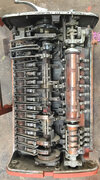" it need to appear in windows as a joystick."I'm still trying to get my head around the fact of do you need a joystick or a switch...???
So you can use an Arduino program that emulates a joystick, but instead of a varying analog value from a pot and ADC (a literal joystick), use the approriate fixed number proportion for whatever notch / switch position is relevant, from the values provided in that list.
Think of it as Windows continually asking the joystick driver "What position is the stick now" - it does not know the source of the replies, or how many possibilities there are, as long as it gets a valid answer.


